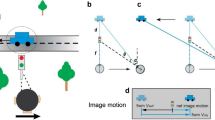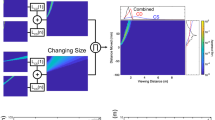Abstract
SINCE Wertheimer's classic paper1, research in motion perception has been concerned with the study of visual illusions such as φ-motion. Various phenomena of this type are easy to elicit by successive changes of the light flux in spatially distinct photoreceptors, and easy to explain by the specific properties of the motion detectors, although there are reports to the contrary2. The present account deals with a less easily comprehensible illusion which is elicited by simultaneous changes of the light flux in differently illuminated receptors3–5. The phenomenon has previously been ascribed to the prolonged latency of the ‘light-on’ responses at lower levels of illumination which converts simultaneous stimuli into successive signals6, but this does not explain the illusion satisfactorily3. MacKay and co-workers were the first to attribute the apparent motion to the adaptive properties of the input channels of the motion detectors4. We show that the illusion can be induced in the fruitfly, Drosophila melanogaster, as well as in man. The course control response to motion provides a quantitative assay of the illusion in the fly. The results suggest that the illusion originates in the distortion of the visual signals before motion detection.
This is a preview of subscription content, access via your institution
Access options
Subscribe to this journal
Receive 51 print issues and online access
$199.00 per year
only $3.90 per issue
Buy this article
- Purchase on Springer Link
- Instant access to full article PDF
Prices may be subject to local taxes which are calculated during checkout
Similar content being viewed by others
References
Wertheimer, M. Z. Psychol. 61, 161–265 (1912).
Kolers, P. A. Aspects of Motion Perception (Pergamon, Oxford, 1972).
Alpern, M. A.M.A. Archs Ophthal. 51, 369–374 (1954).
Andrews, D. P., MacKay, D. M. & Wilson, J. P. Nature 199, 161 (1963).
Anstis, S. M. Science 155, 710–712 (1967).
Lit, A. Am. J. Psychol. 62, 159–181 (1949).
Götz, K. G. Kybernetik 2, 77–92 (1964); 4, 199–208 (1968).
Buchner, E. Biol. Cybernetics 24, 85–101 (1976).
Reichardt, W. & Poggio, T. Q. Rev. Biophys. 9, 311–438 (1976).
Barlow, H. B. & Levick, W. R. J. Physiol., Lond. 178, 477–504 (1965).
Torre, V. & Poggio, T. Proc. R. Soc. 202, 409–416 (1978).
Naka, K. I. & Rushton, W. A. H. J. Physiol., Lond. 185, 536–555 (1966).
Dawis, M. Biol. Cybernetics 30, 187–193 (1978).
Thorson, J. et al. Science 145, 69–71 (1964); 183, 161–172 (1974).
Baylor, D. A., Hodgkin, A. L. & Lamb, T. D. J. Physiol., Lond. 242, 658–791 (1974).
Kramer, L. et al. Biophys. Struct. Mechanism 1, 239–257 (1975); 2, 333–336 (1977).
Gemperlein, R. & Smola, U. J. comp. Physiol. 78, 30–52 (1972); 79, 363–392 (1972).
Author information
Authors and Affiliations
Rights and permissions
About this article
Cite this article
BÜLTHOFF, H., GÖTZ, K. Analogous motion illusion in man and fly. Nature 278, 636–638 (1979). https://doi.org/10.1038/278636a0
Received:
Accepted:
Published:
Issue Date:
DOI: https://doi.org/10.1038/278636a0
This article is cited by
-
Elementary pattern discrimination (behavioural experiments with the fly Musca domestica)
Biological Cybernetics (1986)
-
Deoxyglucose mapping of nervous activity induced inDrosophila brain by visual movement
Journal of Comparative Physiology A (1986)
-
Studies of some new phenomena of motion perception
Biological Cybernetics (1985)
-
Deoxyglucose mapping of nervous activity induced inDrosophila brain by visual movement
Journal of Comparative Physiology A (1984)
-
Movement sensitivities of cells in the fly's medulla
Journal of Comparative Physiology ? A (1980)
Comments
By submitting a comment you agree to abide by our Terms and Community Guidelines. If you find something abusive or that does not comply with our terms or guidelines please flag it as inappropriate.



